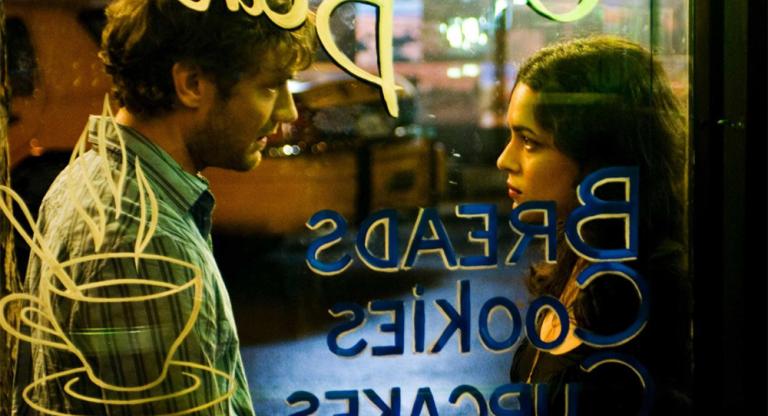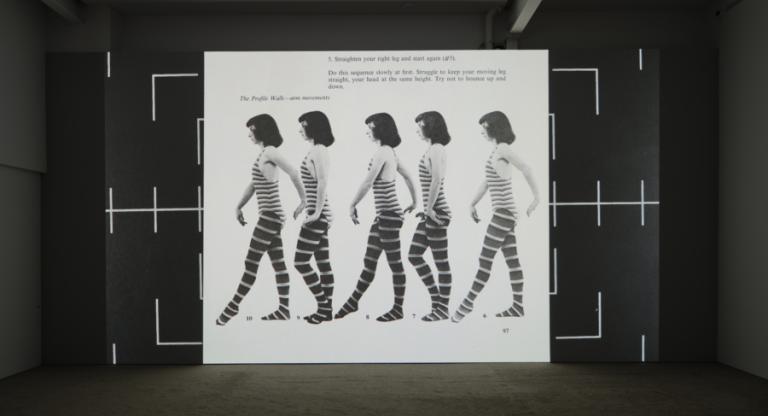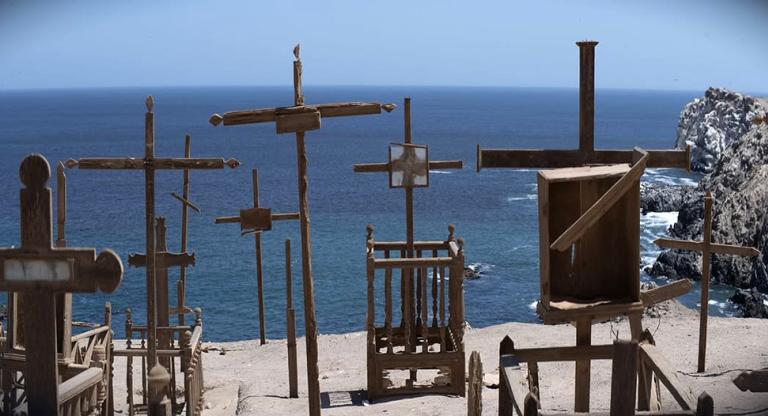Anna Biller is a master at crafting worlds. Between her two features—The Love Witch (2016), with its crystalline imitation of the 1960s medieval revival, and Viva (2007), a film built around 1970s Playboy photoshoots—Biller’s tableaux vivants have cemented her as a meticulous director. Her next undertaking was meant to be an adaptation of the classic Bluebeard narrative, but it was thwarted in pre-production by the pandemic. Instead of scrapping her efforts entirely, she switched forms and wrote her self-described “anti-romance” novel, Bluebeard’s Castle. The title and structure refer to a 17th century French folktale and proto-slasher story about a serial wife-murderer, though the fairytale takes place across multiple cultures and time periods. Equally steeped in the traditions of the Gothic genre and the women’s picture, Bluebeard’s Castle follows a romance novelist, Judith, as she’s dragged into a whirlwind marriage with the dangerously charming Gavin. Its horror stems not just from the crumbling and potentially haunted castle, but from the terror of being trapped with a man who is a relative stranger to her.
I sat down with Anna Biller to discuss her debut novel in advance of tonight’s sold-out screening of Viva at Nitehawk.

Alexandra Coburn: You mentioned a while ago that you were going to shoot a Bluebeard-inspired film. When did that transition into writing a novel?
Anna Biller: Well, actually it was the pandemic. I was shopping the screenplay around for several years, but, for whatever reason, it wasn't working. I found a new producer, but because of the pandemic he shut down operations. So my partner said, “Why don't you just write it as a novel?” The next day, I started writing the novel. I was doing a thousand words per day. I did two edits, and I sent it to Verso. They reached out to me when I wrote on Twitter, “I finished my novel.” My editor at Verso wrote to me on my website and said, “I'd love to read it.”
AC: The writing is very cinematic. Did you ever find yourself having to switch between filmmaker and author mode?
AB: I was thinking about it in a hybrid way in the sense that I was careful not to write anything I wouldn’t want to film later. The book has a lot more than the screenplay had. Screenplays are all about what you leave out. I had hundreds of pages of notes on characters, and I got to put that into the book. When I [began] writing it as a novel, I wanted to make sure it was cinematic, so that somebody would finally say, “Yes, we need to make this movie.” But as I was writing the book I got so absorbed that it stopped being a vehicle to make a film. I was just so invested in writing a good book that would stand on its own.
AC: There has to be part of writing a novel that's freeing in some way, especially when you're talking about what you have to cut from the screen. At the end of the day, there's always going to be somebody else's hand involved in a film.
AB: The page count felt like a luxurious amount of words and pages that I could use. It was very freeing. In fact, it was so much fun. There might be something about novel writing that is more natural to me than screenplay writing. It's also freeing because I think that the reader is more open than the film audience [to] what you're giving them. When you're making a film, you're always thinking about the widest possible audience, if you want to get financing. All the really weird things were not in the screenplay. A lot of what went into Judith's interior monologue was trying to justify why she does what she does. The things she does seem so insane, and when you justify it, it seems even more insane.

AC: Judith’s internal monologue is one of the most fascinating parts because you watch this woman who's obviously an extremely smart person go through these mental gymnastics to explain how she ended up in such a precarious situation. But knowing the tropes didn't save her in the end.
AB: Knowing the tropes actually got her in deeper. In [Daphne du Maurier’s novel] Rebecca, it seems like there's a really scary man, but he's just madly in love. So she's using all of these romance books, which almost always have a happy ending, of course, to justify. In her mind, she is the heroine of her own romance. She knows every nuance of what is happening in her few lucid moments. Then she falls back under his spell again. She would know that he was an abuser, then she would instantly not know it. So it doesn't really have anything to do with intelligence.
AC: You mention the traces of Rebecca, Wuthering Heights, everything in this sort of Gothic tradition. What were you reading while you were writing this?
AB: Well, when I originally wrote the screenplay, I was looking at all the movies: Gaslight [1944], Sudden Fear [1952], Rosemary's Baby [1968], Caught [1949], Night of the Hunter [1955], Suspicion [1941], Rebecca [1940]. You know, movies where there's this man, and the woman doesn't understand him, and he may be planning to kill her, or he may be the love of her life. There were a ton of these films in the Classic period—women's pictures, right? So when I started writing the book I read every most famous Gothic novel, like 50 novels. I also was reading Tess of the d'Urbervilles, and another book that was really key for me was Diary of a Madman.
AC: There are references to various horror films, novels, and Gothic romances. Even the cover references this pre-Fabio, ’50s or ’60s, illustrated beautiful-maiden trope, which is funny because in the book Gavin has illustrations based on her novel covers hung all over the castle.
AB: You know, that's something that also happened in the movie Sudden Fear. Joan Crawford plays a very successful playwright, and she has everything she wants but the love of a man. This actor seduces her, and in order to seduce her, he quotes from her own books. So that's what Gavin does. He learns all of Judith’s fantasies, and they’re right there in the open in all her books, so he embodies them. It's almost like how women sometimes reveal themselves online. It'd be so easy for a man to just come in and trick that woman because he knows. He has all the information. It's scary to think about that.

AC: Throughout the book, you talk about the performative dimension of being someone's lover or being in a relationship. That's something that also comes across in Viva and The Love Witch.
AB: Well, to be a woman is to play a role, right? Actually, to be a man is to play a role, as well. Gender is role-playing, and then courtship is often based on people performing those roles. A lot of the excitement and the charge of sexual relationships is playing a role. Judith just has never gotten to play the feminine role, because no one's ever cast her in that light.
AC: Right, and you get the idea that there's an autoerotic aspect of female sexuality. It becomes more about the other person as the mirror that's reflecting back what you want to see sexually.
AB: It becomes anti-romance. The whole point of romance is to feel like you're the center of this incredible man's lust, and this man has so much lust that it turns him into a monster. His desire for you is so great that he broke all these taboos. You can forgive him because it came from his deep, not only lust, but love for you. That's why people consume romance novels like candy. But the guys who can give you your fantasy right away are often just con artists, right?
AC: Viva and Bluebeard's Castle both interrogate the boundaries of kink. What's really skillful is that it's sometimes hard to tell what she enjoys and what she's convinced she's enjoying. That may be the great question of female erotica.
AB: That's the scariest part of the book to me. Where are her boundaries? You get the sense that he pushed her beyond her boundaries, maybe on that very first night, and that he broke her a little bit. The kink community's always like, “Oh, everything's based on this cheerful consent,” but human beings aren't like that. So I always think it's so funny, because in non-kink relationships, the bullshit and the abuse that goes down are just regular, non-kink questions, right? Kink is treated as the only area where everything's always completely consensual and completely safe. The issue of consent is just a really sticky one. Somebody can consent because they want something other than what’s being offered sexually. I mean, that happens a lot. You know, people can have sex because they want drugs or money, and sometimes they just want love. Like the Armie Hammer situation. She consented, but under duress of him saying, “I won't love you if you don't try this.”
AC: There was a line in the book where she says, “Will I just submit to whatever man is willing to violate my boundaries?”
AB: Another thing I want to say about the relation between Viva and Bluebeard's Castle is in Viva, it's really about Playboy magazine. I tore all these things from Playboy, laid them down on the floor, and actually made a narrative out of them. Women are featured on all the pages of Playboy, and that's why people bought the magazine, but women are completely absent from the narrative. They have this stupid questionnaire on the back of the centerfolds, you know, saying, “Oh, I don't like jealous people.” Right? Or jeans, or whatever. Otherwise they're just naked and smiling. There's not a person there. I'm interested in putting the female point of view where there isn't a female point of view.
Part of the reason I became interested in making a Bluebeard movie is in response to all the slasher films that I've seen. People try to say those movies are empowering for women because there's the final girl. I'm sorry, but if you're honest with yourself, you understand that the main spectacle in those films is not to watch the final girl’s triumph but to watch all the other ‘slutty’ women get murdered. The genre has changed somewhat, but the original ones were really scary because it was all about punishing female sexuality. A woman dresses provocatively or she's acting like a bitch, and that woman gets brutally sexually murdered and dragged away somewhere. It really terrified me, especially as a kid.
The virginal woman who is the final girl doesn't really have a voice. She's just the one who didn't transgress the male law and wasn't slutty and didn't talk back, and so she got to live. It seems to me to be a message to women. Before slasher films, we had “woman in peril” films where it really was about a heroine surviving. I want to make a movie that brings back this kind of thriller. It's empathetic towards women or from a woman's point of view. I wanted to make a horror movie for women about what women are afraid of. It's not about the male fantasy of destruction.

AC: Now that you brought up the different eras: in Bluebeard you're almost jarred by mentions of texts or vape pens.
AB: Because I want to really be clear that this is not just about women in the ’40s or ’50s. It was the same with The Love Witch. The imagery had to feel like the ’60s because that was when all these ideas about witchcraft and witches came about. But it still is now. I was a little frustrated when I made Viva. A lot of people were thinking that these are issues that happened to women in the early ’70s. There was so much discussion of how this was funny because it's dated, but I don't want to give people that out in thinking that this doesn't happen anymore. We can laugh if it’s from the past, right?
What I really love about Rebecca is that it’s set in its contemporary time, the 1940s, but everything about it feels almost medieval. The clothing is modern, but the castle and atmosphere and everything about it is so Gothic. If you hadn't seen it for a while, you might imagine that it took place in the 1850s. She's trapped in a castle, which is this ancient thing, and she's with a monster who's almost like Bram Stoker's Dracula.
And then I found out that actually, I do enjoy older romance books. I found those novels to be like watching a classic women's picture. 1940s romance books are really, really fun, and they have some excellent writing by authors who have a background in literature. Like Victoria Holt, who wrote Mistress of Mellyn, was very educated. There are rules now that they didn't used to have, like the rule that you have to have a happily-ever-after ending, and that limits what you can do with your character.
AC: Gavin actually reminded me of Stoker’s Dracula, yes. There’s a specific reference Judith makes to feeling like she’s Lucy and he’s Dracula, and she’s entering these trance-like fantasy states where she seems irresponsible for her actions.
AB: I live a lot of my fantasy life like Judith. I imagine myself as living in another time. It's just easier for me to process. I want beauty. I want the prettiness, because otherwise it's too ugly. Sometimes I would watch these serial killer movies, and they’re so obvious. They have no mystery to them. You have to put art in there. Art is key, in a way: the imagery you use, the words, the language, the lighting. The style is at least as important as the story.

AC: I’m also curious about the role religion and spirituality have in this novel. In The Love Witch you’re playing with the idea of Wicca and the way that took off. With the novel, it’s Catholicism and her relationship specifically with the Virgin Mary and Catherine of Siena.
AB: Well, because Judith didn't have a mother, so they became her mothers. This is what people do when they're in despair. She later uses the Church as a kind of a fetish object, and it intertwines with her Gothic fantasies. She's fetishizing her own Gothic Catholic weirdness. I was inspired by the movie Viridiana [1961]. There's a scene that shows her praying, and you see a hammer and a crown of thorns or something. It's so hilarious and so scary. I just thought, “God, that's so real.” If you want to self-flagellate, Catholicism gives you all the tools.
AC: You talk about the veneration of the Virgin Mary in congruence with the fact that the church has denigrated women for so long. Judith almost used that as a way to explain Gavin's treatment of her. There's veneration and there's degradation in constant oscillation. She had to be his idol or his fetish object. But really, she was just some girl to him. And that's the scariest part.
AB: People self-fetishize. She's really prone to that. But—and I may just be a freak—I think we all do. A lot of my work comes out of that, so I’m making fun of myself a little bit when I'm creating a character like that.
AC: I have to say, when I was starting film school and The Love Witch came out, it was a lightbulb moment for me and a lot of women I was in school with. Finally, something that came out in this era was addressing things that we were wondering about, and the ways we had felt and been unable to express.
AB: When I was growing up, I didn't have any movies made in my own time that I related to in that way. I had to go back decades. I just really want to make films that young women are able to watch and say, “Yes, this speaks to me.”
Viva screens tonight, August 17, at Nitehawk Prospect Park on 35mm, followed by a conversation with director Anna Biller. She will also appear at The Strand on October 12 for the book launch of Bluebeard’s Castle.




